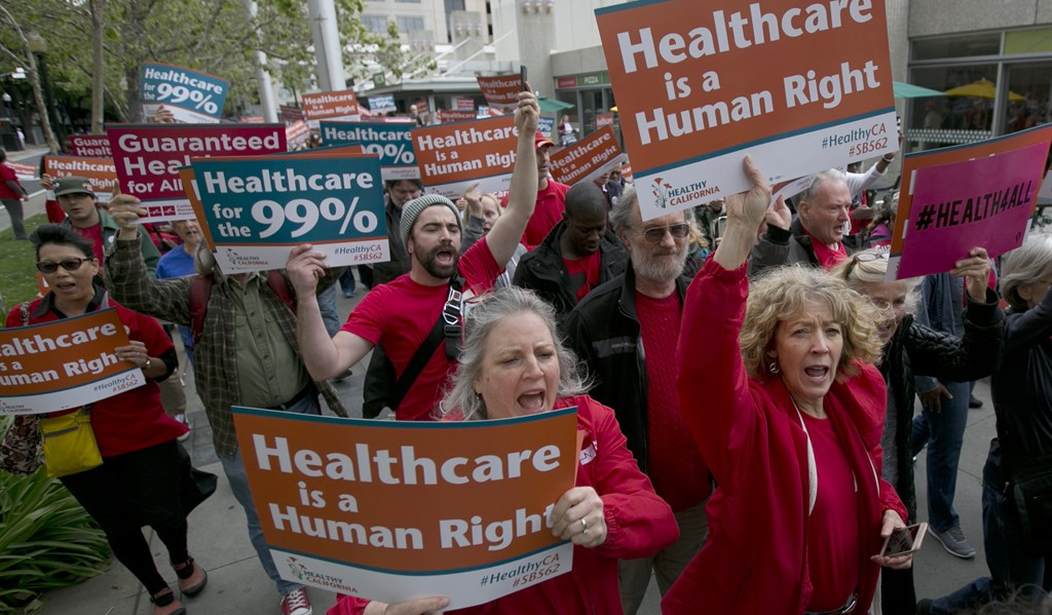Cooler heads prevailed in Vermont and Colorado when single-payer fever struck those states. Both eventually bailed on the idea when disastrous fiscal projections finally forced the hand of either voters (Colorado) or progressive proponents (Governor Peter Shumlin in Vermont). After the Democrat-dominated state senate in California got the bad news on its SB562 bill for single payer in the Golden State, the question of whether common sense will prevail there has now arisen.
So far, it doesn’t look good, according to a report from Kaiser Health News, via Newsweek:
A single-payer system likely “would be more efficient in delivering healthcare,” said Larry Levitt, a senior vice president at the Kaiser Family Foundation. (California Healthline is produced by Kaiser Health News, an editorially independent program of the Kaiser Family Foundation.)
But the proposal expands coverage to all and eliminates premiums, copayments and deductibles for enrollees, and that would cost more money, Levitt said. “You can bet that opponents will highlight the 15 percent tax, even though there are also big premium savings for employers and individuals,” he added.
State Sen. Ricardo Lara (D-Bell Gardens), a chief sponsor of the legislation, said the present system is unsustainable because health spending continues to grow faster than the overall economy, making coverage unaffordable for too many people.
Lara touted the potential savings from creating a public plan with greater bargaining power and cutting out the administrative overhead and profits of private health insurers acting as middlemen.
The news is bad enough from the projections, but as Stephen Greenhut reminds readers today, projections in health-care policy tend to understate costs:
And, quite significantly, these costs could be understated given the kind of demand that would be created by this system. Its main advocates, Sens. Ricardo Lara, D-Bell Gardens, and Toni Atkins, D-San Diego, view health care as a “human right,” so the system the bill would create would provide nearly unlimited access to medical care. In fact, the Senate health committee report opined that “SB562 will change health care in California from commodity to a right.”
“Under the bill, enrollee access to services would be largely unconstrained by utilization management tools commonly used by health care payers, including Medi-Cal,” according to the committee report. “The ability for enrollees to see any willing provider, to receive any service deemed medically appropriate by a licensed provider, and the lack of cost sharing, in combination, would make it difficult for the program to make use of utilization management tools … . Therefore, it is very likely that there would be increased utilization of health care services under this bill.”
And the committee only is talking about predicted costs. It’s not its job to engage other policy debates, such as those touching on subjects including rationing, waiting lists for services if the demand overwhelms supply and the quality of care. The bill would apply to illegal immigrants, which raise critics’ concerns about the state becoming a worldwide magnet for “free” health care.
That points up another problem in the proposals for closing the funding gap on single payer. The two mechanisms most mentioned are either a payroll tax on workers, or business taxes. Both of these rely on employment, but access to the system is not limited to those employed, or even those legally able to gain employment. That will attract non-workers from across the US, whose utilization curve will send costs skyrocketing.
As I wrote in my column for The Week, just the projected cost curves were enough to sink single payer in other states. The options for dealing with worse-than-projected outcomes were bleak, needless to say:
The solutions for this fiscal meltdown in a single-payer system, CHI noted, were all unpleasant. One option would be to cut benefits of the universal coverage, and hiking co-pays to provide disincentives for using health care. That would in some cases “reduce the level of insurance below what [Coloradans] have today,” the study noted. The state could raise taxes for the health-care system as deficits increased, which would amount to ironic premium hikes from a system designed to be a response to premium hikes from insurers. Another option: Reduce the payments provided to doctors, clinics, and hospitals for their services, which would almost certainly drive providers to either reduce their access or leave the state for greener pastures.
Those are the only options available in closed systems. Our experiences with other state-run single-payer systems in the U.S. only reinforce the conclusions reached by CHI. Medicare and Medicaid have attempted to restrict provider payments while expanding their enrollments, and as a result providers have greatly reduced their access to new patients from both systems. The Veterans Administration has wait times for its clinics that stretch out so long as to have resulted in patient deaths, along with rampant corruption to hide failures and protect the bureaucrats at the expense of the patients. The Indian Health Service, which provides care to those on reservations, has such crises of funding that Native Americans stuck in the system joke about not getting sick after June.
When faced with the realities of single-payer systems, Colorado voters took the rational choice and overwhelmingly rejected it. California taxpayers had better hope that their elected officials make the same decision, but in this case, the third time might be the charm … for disaster.
So will California learn these lessons the easy way, or the hard way? The study has at least slowed down the action in the state legislature. The Senate committee stalled a vote on the proposal, and now advocates apparently believe that it will come up for a vote next month — or at least hope it does. That assumes that California legislators have less sense than voters in Colorado or Democrats in Vermont. And that projection may not be all that unreasonable, especially since they’ve ignored the earlier lessons to come this far.








Join the conversation as a VIP Member